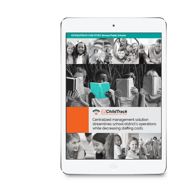
Setting goals is a laudable and necessary exercise when implementing improvements in your educational system. However, many educators doubt the effectiveness or results of school improvement plans (SIPs).
A RAND survey found that only 44% of teachers and 67% of principals believe SIPs change teaching practices, while only 62% of teachers and 81% of principals believe SIPs improve schools over five years. Those are hardly convincing statistics. When more than half of teachers and a third of principals don't believe in the effectiveness of improvement plans, administrators should sit up and take notice.
Typical Obstacles to School Improvement
The most common issue with goal setting is unreasonable achievement targets. You are unlikely to reach your goals if you expect a 30% increase in ELA proficiency or a 54% increase in math proficiency. Targets of 4% and 6%, respectively, are more reasonable.
When you set targets without substantive goals, action steps, or strategies for achievement, your plan ultimately falls short. Even when the plan has goals, strategies, or steps, they may have been written by someone who does not spend time in a classroom and is unfamiliar with how a school operates.
Administrators who take responsibility for all the steps outlined in the SIP or delegate specific tasks without matching the tasks to the responsibility for the larger goal connected to the task will find the SIP floundering and mired due to a lack of incentive and control.
Strategies for Setting Achievable Goals
Before you set goals, you need passion and purpose. When do you give the most effort toward meeting a goal? Isn’t it when you are passionate about the outcome and feel a sense of purpose in reaching the goal?
Instead of assigning goals, let the staff choose them as long as they align with school goals. Consider what aspects of the school's mission excite teachers and the improvements they might make.
Once you find the passion, pair it with purpose. Purpose makes achieving goals more manageable and more likely over the long term. Learn the teacher's passion and purpose behind their goals by asking:
- Why did you choose this goal?
- Why does reaching it matter to you?
- How do you think gaining this goal benefits others and the school?
You are probably already familiar with SMART goals. The acronym stands for:
- Specific
- Measurable
- Attainable
- Relevant
- Timely
Ask staff how they will know they reached their goal and what would be different in their classroom as a result. Go beyond numbers and measurements to qualitative changes.
Plan for Overcoming Obstacles
Unfortunately, nothing worthwhile is easy. You always have obstacles that crop up in even the best-laid plans. Are you ready for another acronym? Implement intentions using WOOP.
- Wish - what would you like to achieve and why
- Outcome- visualize how it would look and feel to reach your goal
- Obstacles - what could keep you from meeting your goals? What has blocked your success in the past?
- Plan - if obstacles occur, how do you plan to overcome them?
Brainstorm potential obstacles with teachers and staff. Those on the front lines have intimate knowledge of the day-to-day challenges and where previous plans have foundered. Once you identify obstacles, plan what to do before they happen.
Incorporate Check-ins and Feedback
Meeting only once or twice during the academic year will not yield enough feedback about progress toward goals.
Reaching a goal is an ongoing process. Create regular opportunities to meet with staff and gain feedback about their tasks and progress.
What successes have they had? What obstacles have they met? What are their next steps toward overcoming barriers and moving toward their goals?
Monthly faculty meetings are excellent venues for checking in with accountability partners and asking others for advice in solving problems.
Tactics for Implementing Your Strategies
Responsibilities, metrics, goals, documented processes, regular leadership inspection, and feedback on progress toward goals drive daily improvement efforts. We already talked about assigning responsibilities, determining reasonable goals, and feedback. Now we need to talk about measurement.
You must hit the sweet spot between measuring too often and not enough.
Monitoring measurements weekly is achievable and provides timely data in case you need to make changes mid-course in your improvement plan. Perhaps a process can be more fluid, or one of your chosen metrics doesn't provide actionable information.
Twice-a-year monitoring may not be often enough, especially for schools going through a lot of change. While tradition dictates following up in October and February, you will likely work with projections rather than factual data. You risk placing too much stress on teachers and leaders to show huge steps toward a goal.
A low-stakes weekly status meeting provides timely and actionable data to map against the goal and plan. If you spot a trend in the wrong direction, you can adjust quickly to get back on track.
For example, your reading coach can facilitate subject planning with all ELA teachers during their common planning periods, focusing on improving the target and task alignment during the first grading period with a research-based classroom walkthrough tool.
Hold continuous improvement meetings with daily standups. The principal owns the standup meeting and gathers the team around an action board that illustrates the plan, goals, and associated tasks.
A standup gives the team five to fifteen minutes to discuss progress, obstacles, and next steps. Set the meeting for the same time and location each day, with no exceptions or excuses. Ensure data is central to all discussions.
An action board shows all steps and labels them done, in process, or not yet started. Status should change regularly, and obstacles to achieving done status are a top priority for discussion.
Collect your data, reflect on the results, and try again. A plan is your best guess about what you can do to achieve your established goal. Implementation is more like experimenting, changing variables and constants as needed.
Wrapping Up
Goal setting requires more than a list of items you want your school to achieve. You must set attainable goals while envisioning how your team can reach the goal and the types of changes that the goal achieves.
Look for passion and purpose in the goals to incentivize teachers and staff to continue toward the goal enthusiastically. Make a plan to overcome obstacles and have regular meetings to gain feedback against progress and keep everyone up-to-date on progress.
When you set SMART goals and delegate tasks appropriately, everyone is a stakeholder that pushes your school through the improvement plan.




